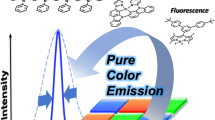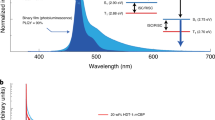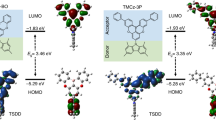Abstract
Luminescent materials that exhibit narrowband emission are vital for full-colour displays. Here, we report a thermally activated delayed-fluorescence material that exhibits ultrapure blue emission with full-width at half-maximum of just 14 nm. The emitter consists of five benzene rings connected by two boron and four nitrogen atoms and two diphenylamino substituents. The multiple resonance effect of the boron and nitrogen atoms induces significant localization of the highest occupied and lowest unoccupied molecular orbitals on different atoms to minimize not only the vibronic coupling between the ground state (S0) and the singlet excited state (S1) but also the energy gap between the S1 state and triplet excited state (T1). Organic light-emitting diode devices employing the emitter emit light at 469 nm with full-width at half-maximum of 18 nm with an external quantum efficiency of 34.4% at the maximum and 26.0% at 1,000 cd m−2.
This is a preview of subscription content, access via your institution
Access options
Access Nature and 54 other Nature Portfolio journals
Get Nature+, our best-value online-access subscription
$29.99 / 30 days
cancel any time
Subscribe to this journal
Receive 12 print issues and online access
$209.00 per year
only $17.42 per issue
Buy this article
- Purchase on Springer Link
- Instant access to full article PDF
Prices may be subject to local taxes which are calculated during checkout




Similar content being viewed by others
Data availability
The data that support the plots within this paper and other findings of this study are available from the corresponding author upon reasonable request.
References
Park, S. et al. Printed assemblies of inorganic light-emitting diodes for deformable and semitransparent displays. Science 325, 977–981 (2017).
Zhang, K., Peng, D., Lau, K. M. & Liu, Z. Fully-integrated active matrix programmable UV and blue micro-LED display system-on-panel. J. Soc. Inf. Disp. 25, 240–248 (2017).
Cok, R. S. et al. Inorganic light-emitting diode display using micro-transfer printing. J. Soc. Inf. Disp. 25, 589–609 (2017).
Colvin, V. L., Schlamp, M. C. & Alivisatos, A. P. Light-emitting diodes made from cadmium selenide nanocrystals and a semiconducting polymer. Nature 370, 354–357 (1994).
Coe, S., Woo, W. K., Bawendi, M. & Bulovic, V. Electroluminescence from single monolayers of nanocrystals in molecular organic devices. Nature 420, 800–803 (2002).
Yang, Y. et al. High-efficiency light-emitting devices based on quantum dots with tailored nanostructures. Nat. Photon. 9, 259–266 (2015).
Dai, X., Deng, Y., Peng, X. & Jin, Y. Quantum-dot light-emitting diodes for large-area displays: toward the dawn of commercialization. Adv. Mater. 29, 1607022 (2017).
Tang, C. W. & VanSlyke, S. A. Organic electroluminescent diodes. Appl. Phys. Lett. 51, 913–915 (1987).
Baldo, M. A. et al. Highly efficient phosphorescent emission from organic electroluminescent devices. Nature 395, 151–154 (1998).
Takeda, N., Tsutsui, T. & Saito, S. Control of emission characteristics in organic thin-film electroluminescent diodes using an optical microcavity structure. Appl. Phys. Lett. 63, 2032–2034 (1993).
Santoro, F., Lami, A., Improta, R., Bloino, J. & Barone, V. Effective method for the computation of optical spectra of large molecules at finite temperature including the Duschinsky and Herzberg–Teller effect: the Qx band of porphyrin as a case study. J. Chem. Phys. 128, 224311 (2008).
Sato, T., Tokunaga, K., Iwahara, N., Shizu, K. & Tanaka, K. in The Jahn–Teller Effect Vol. 97 (eds Koppel, H., Yarkony, D. & Barentzen, H.) 99–129 (Springer Series in Chemical Physics, Springer, 2009).
Hatakeyama, T. et al. Ultrapure blue thermally activated delayed fluorescence molecules: efficient HOMO–LUMO separation by the multiple resonance effect. Adv. Mater. 28, 2777–2781 (2016).
Uoyama, H., Goushi, K., Shizu, K., Nomura, H. & Adachi, C. Highly efficient organic light-emitting diodes from delayed fluorescence. Nature 492, 234–238 (2012).
Masui, K., Nakanotani, H. & Adachi, C. Analysis of exciton annihilation in high-efficiency sky-blue organic light-emitting diodes with thermally activated delayed fluorescence. Org. Electron. 14, 2721–2726 (2013).
Zhang, Q. et al. Efficient blue organic light-emitting diodes employing thermally activated delayed fluorescence. Nat. Photon. 8, 326–332 (2014).
Hirata, S. et al. Highly efficient blue electroluminescence based on thermally activated delayed fluorescence. Nat. Mater. 14, 330–336 (2015).
Cho, Y. J. et al. Donor interlocked molecular design for fluorescence-like narrow emission in deep blue thermally activated delayed fluorescent emitters. Chem. Mater. 28, 5400–5405 (2016).
Park, I. S., Matsuo, K., Aizawa, N. & Yasuda, T. High-performance dibenzoheteraborin-based thermally activated delayed fluorescence emitters: molecular architectonics for concurrently achieving narrowband emission and efficient triplet–singlet spin conversion. Adv. Funct. Mater. 28, 1802031 (2018).
Cui, L.-S. et al. Controlling singlet–triplet energy splitting for deep-blue thermally activated delayed fluorescence emitters. Angew. Chem. Int. Ed. 56, 1571–1575 (2017).
Rajamalli, P. et al. New molecular design concurrently providing superior pure blue thermally activated delayed fluorescence and optical out-coupling efficiency. J. Am. Chem. Soc. 139, 10948–10951 (2017).
Wada., Y. et al. Adamantyl substitution strategy for realizing solution-processable thermally stable deep-blue thermally activated delayed fluorescence materials. Adv. Mater. 30, 1705641 (2018).
Etherington, M. K. et al. Revealing the spin–vibronic coupling mechanism of thermally activated delayed fluorescence. Nat. Commun. 7, 13680 (2016).
Samanta, P. K., Kim, D., Coropceanu, V. & Brédas, J.-L. Up-conversion intersystem crossing rates in organic emitters for thermally activated delayed fluorescence: impact of the nature of singlet vs triplet excited states. J. Am. Chem. Soc. 139, 4042–4051 (2017).
Hatakeyama, T., Hashimoto, S., Seki, S. & Nakamura, M. Synthesis of BN-fused polycyclic aromatics via tandem intramolecular electrophilic arene borylation. J. Am. Chem. Soc. 133, 18614–18617 (2011).
Nakatsuka, S., Gotoh, H., Kinoshita, K., Yasuda, N. & Hatakeyama, T. Divergent synthesis of heteroatom-centered 4,8,12-triazatriangulenes. Angew. Chem. Int. Ed. 56, 5087–5090 (2017).
Matsui, K. et al. One-shot multiple borylation toward BN-doped nanographenes. J. Am. Chem. Soc. 140, 1195–1198 (2018).
Nakatsuka, S., Yasuda, N. & Hatakeyama, T. Four-step synthesis of B2N2-embedded corannulene. J. Am. Chem. Soc. 140, 13562–13565 (2018).
Hirai, H. et al. One-shot borylation of 1,3-diaryloxybenzenes towards efficient materials for organic light-emitting diodes. Angew. Chem. Int. Ed. 54, 13581–13585 (2015).
Xian, C. et al. Efficiency roll-off in blue emitting phosphorescent organic light emitting diodes with carbazole host materials. Adv. Funct. Mater. 26, 1463–1469 (2016).
Acknowledgements
This study was supported by the ACCEL (JPMJAC1305) and CREST (JPMJCR18R3) programmes from the Japan Science and Technology Agency (JST), a Grant-in-Aid for Scientific Research on Innovative Areas ‘π-System Figuration’ (JP17H05164) and a Grant-in-Aid for Scientific Research (JP18H02051) from the Japan Society for the Promotion of Science (JSPS), Iketani Science and Technology Foundation and Mitsubishi Foundation. Preliminary measurements for the X-ray crystal structure analysis were performed at BL40XU in the SPring-8 with the approval of JASRI (2016A1052, 2016B1059, 2017A1132, 2017B1073, 2018A1114, 2018B1125) and with the help of N. Yasuda (JASRI). The authors thank T. Matsushita, K. Shiren, R. Kawasumi (JNC Petrochemical), Y. Honda (HPC Systems) and S. Nakatsuka (Kwansei Gakuin University) for valuable input.
Author information
Authors and Affiliations
Contributions
T.H. planned and supervised the project, designed the compounds and wrote the manuscript. Y.K. fabricated the OLED devices and measured the characteristics. T.H. and K.Y. performed the calculations. H.N., S.K. and K.Y. synthesized the compounds and measured the characteristics. S.O., H.G., Y.S. and M.Y. supported the synthesis and fabrication. T.H. and S.O. revised the manuscript.
Corresponding author
Ethics declarations
Competing interests
The authors declare no competing interests.
Additional information
Publisher’s note: Springer Nature remains neutral with regard to jurisdictional claims in published maps and institutional affiliations.
Supplementary information
Supplementary Information
Chemical structure, photoluminescence spectra, NMR data
Rights and permissions
About this article
Cite this article
Kondo, Y., Yoshiura, K., Kitera, S. et al. Narrowband deep-blue organic light-emitting diode featuring an organoboron-based emitter. Nat. Photonics 13, 678–682 (2019). https://doi.org/10.1038/s41566-019-0476-5
Received:
Accepted:
Published:
Issue Date:
DOI: https://doi.org/10.1038/s41566-019-0476-5
This article is cited by
-
Enhancing the efficiency and stability of blue thermally activated delayed fluorescence emitters by perdeuteration
Nature Photonics (2024)
-
Management of triplet excitons transition: fine regulation of Förster and dexter energy transfer simultaneously
Light: Science & Applications (2024)
-
Highly efficient multi-resonance thermally activated delayed fluorescence material toward a BT.2020 deep-blue emitter
Nature Communications (2024)
-
Efficient, narrow-band, and stable electroluminescence from organoboron-nitrogen-carbonyl emitter
Nature Communications (2024)
-
Key requirements for ultraefficient sensitization in hyperfluorescence organic light-emitting diodes
Nature Photonics (2024)



